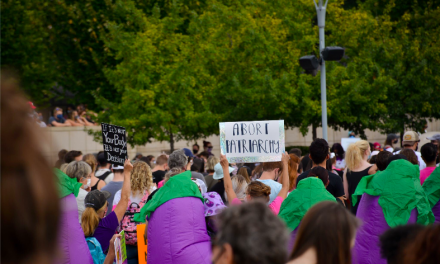In 2014, the U.S. health care system was “not at all prepared” for an outbreak like Ebola, but Emory still took in four patients in hopes of successfully treating them, according to Bruce Ribner, professor of medicine and the medical director for Emory University Hospital (EUH)’s Serious Communicable Disease Unit (SCDU). Three years after successfully treating the patients, Emory researchers are using their knowledge to improve emergency responses for future outbreaks.
Using blood samples and medical information from the four Ebola patients treated three years ago, researchers are attempting to develop Ebola virus disease vaccines, according to Ribner. Emory researchers are also studying methods to provide care to Ebola survivors, several of whom face lasting disabilities such as blindness and anxiety, according to Ribner.
Four Emory patients’ blood could lead to cure
EUH has “phenomenal” capabilities to study the virus because it treated four Ebola patients during the outbreak, said Ribner, who established the SCDU in 2001 and has worked in the unit since. Emory was the first institution to successfully treat an Ebola patient in the United States, ultimately treating four of 11 cases in the U.S., according to Ribner.
Ribner, who led the team of health care workers that treated the patients, said that EUH has learned more about the virus from those four patients than many resource-poor countries in West Africa have learned from their thousands of local patients.
“A lot of our research is driven by tests we did on our patients,” Ribner said. “It’s logistically a lot easier to not have to transport specimens, so it’s a lot more convenient to have labs, researchers and premier technology where the patients already are.”
Aneesh Mehta, the assistant director of transplant infectious diseases at EUH, conducts research to develop a vaccine for future Ebola outbreaks. Mehta draws upon his experiences and knowledge as the physician on call when the first Ebola patient arrived at Emory for treatment in 2014 to conduct this research.
The SCDU began its laboratory research just a few days after the second Ebola patient arrived in Atlanta, Mehta said.
Emory Vaccine Center Director Rafi Ahmed and his team, along with the SCDU, collected the patients’ blood to study how the Ebola virus changed over time in the blood; which antibodies were being produced to protect the patients; and how cells adapt to fight the infection. The research is funded through a grant by U.S. Department of Defense’s Defense Advanced Research Projects Agency (DARPA), according to Mehta.
After studying these samples, Emory researchers determined that all four patients’ B and T cells, which help the immune system to fight Ebola, were active, according to Mehta. That discovery contradicted previous research, which had proposed that immune responses to Ebola were impaired.
Now, Emory researchers are using their findings to develop new drugs and treatments for Ebola, Mehta said. After Ahmed’s team cloned the antibody-creating cells to test which are most effective in fighting the disease, the team found some candidate antibodies, which are currently being tested in animals, Mehta added.
Prior to their research, most Ebola research was conducted on monkeys who were experimentally infected or patients who were enrolled in clinical studies well after being cured of the Ebola virus, according to Mehta.
Emory is the only center in the U.S. that has banked plasma of Ebola survivors, Mehta said. The blood plasma of a cured individual contains antibodies, which can be used to treat others with the same infection. Emory banked plasma from the patients it treated, so if another Ebola patient needs treatment and a new therapeutic is not yet available, Emory will still be able to provide them with antibodies to fight the disease, Mehta said.
Ebola leaves its mark on survivors
The majority of Ebola survivors are left with disabilities, and Emory has been studying ways to alleviate the distress for survivors.
One of the most common disabilities is visual impairment, including blindness, according to Ribner. Ian Crozier, one of the patients treated at Emory, developed uveitis, a condition characterized by inflammation of the uvea, roughly 100 days after he was discharged from EUH. His eye fluids still contained live Ebola virus, and he had severe eye inflammation, said Steven Yeh, the principal investigator of Emory Eye Center’s Quiet Eye West Africa (QEWA) team.
The QEWA team travels to West Africa every few months to assess Ebola survivors and sample eye fluids. QEWA also researches uveitis in survivors. Uveitis is reported in anywhere from 13 to 34 percent of Ebola virus disease survivors, according to Jessica Shantha, a co-investigator for QEWA.
The team also aims to provide the uveitis patients with cataract surgery through partnerships with eye surgeons in West Africa and uveitis screening education, Yeh added.
“Ebola survivors develop a host of other non-opthalmology issues like arthritis, mental health disorders, anxiety and other issues of viral persistence,” Yeh said. “Eye disease is one manifestation of post-Ebola virus syndrome, so this research has been important in recognizing that survivors need systematic care.”
West Africa may not have the ability and resources necessary to help survivors cope with blindness acquired from the disease, Ribner said.
Emory faculty and researchers also lead the National Ebola Treatment and Education Center (NETEC), which aims to prepare health care systems to cope with cases of special pathogens through resource collaboration, according to its website. NETEC evaluates health care systems on their ability to treat patients with serious communicable diseases and publishes guidelines for proper treatment to increase emergency preparedness for serious communicable diseases, Ribner added.
In summer 2015, the U.S. Department of Health and Human Services approached Emory, along with the University of Nebraska Medical Center and the New York Health and Hospitals Corporation/Bellevue Hospital Center, to create NETEC because they each independently treated Ebola patients in 2014. Emory was later selected to lead NETEC, while the other facilities held supporting roles.
“Fortunately, the government realized [that the U.S. was not prepared for an outbreak like Ebola] and published large funding bills [for NETEC],” Ribner said. “Whenever the next outbreak occurs, we will be much more timely in initiating protocols for medical interventions to promote survival and clinical care.”
Regional Ebola and other Special Pathogen Treatment Centers (RESPTC) met at the NETEC Summit at Emory last June to discuss best practices for clinical preparedness of the virus. The summit’s goal was to increase linkage between NETEC and other federally-funded health care regions in the U.S. to form a “more cohesive, robust network” against infectious diseases, Ribner said.
In February, NETEC received a supplemental $12 million in funds, for a total of $24 million, from the Centers for Disease Control and Prevention (CDC) and the Office of the Assistant Secretary for Preparedness and Response (ASPR) through the U.S. Department of Health and Human Services, according to an Emory press release.
Mehta said that the patients treated in 2014 are still “very engaged” with Emory’s research today.
“They are always asking about what we’re doing and are excited to see the results of their donation to science, which is a great thing for us, as physicians, to see,” Mehta said.
Lauren is an Environmental Science and Media Studies double major from Braselton, Georgia. She is a staff writer for the Emory Wheel, a member of Pi Beta Phi, president of Emory Running Club and a member of the Emory Environment Senate Committee. In her free time, she likes to play with her four dogs, including one named Kat!




